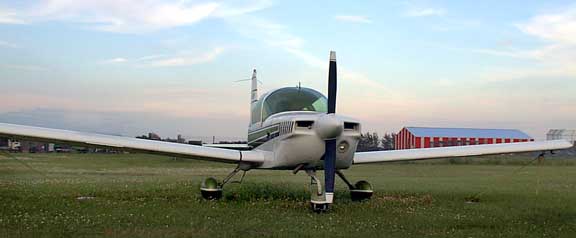 |
| FTLComm - Tisdale - July 26, 2000 |
 I think it was the fall of 1970 that I first saw this design when a sales representative flew one of the earliest versions, the American Yankee, a two seat trainer, into Regina from the Cleveland factory. At $21,000 it was one of the least expensive aircraft ever brought into production and one of the most cleverly designed machines to rise above the ground. Aircraft designer, Jim Bede had established himself as a smart designer for amateur kit built aircraft and though he came up with some great designs this was by far the most interesting and perhaps had the greatest effect on the industry as a whole. Bede, like others, had realised the conventional |
| construction techniques in use were a legacy from the past and were enshrined in the regulations that determine what must go into an aircraft. Many of these traditions have seriously hampered innovation and gradual improvements but Bede took a bold step and in his design came up with two remarkable innovations. The efficient design for a flying machine involves a number of compound curves that tax the skills of metal forming and add a huge cost to the final product. In his American Yankee design he built what is essentially a tapered box of a fuselage with a simple fibreglass nose cover. This flat sided design added considerably to the aircraft's inexpensive construction. |
 |
| The next problem Bede solved was building sturdy wings. He achieved this in two ways. The structure that would give strength to the wings was the main spar and for this he developed an extruded aluminum tube that carried the aircraft's fuel and each wing slide on to with the wings ribs glued in place. |
 Yes you read that right, "glued" this was the key to making the best looking wing ever until composite wings appeared on aircraft. Bede developed a honey comb structure which formed the wing with the skin "bonded" forming a rivet less smooth wing. Putting rivets into metal is an enormously expensive labour intensive process and Jim Bede's glue job cut production costs and improved quality. Of the many accomplishments of Jim Bede being a successful business man is not on the |
| list. He did not offer this aircraft as a kit but instead set up his own manufacturing plant in Cleveland to produce the Yankee. He was soon in trouble financially and sold the design and production rights to Grumman who with their marketing skill and financial backing made this a successful aircraft. Grumman produced the initial two seat trainer but also developed a stretched four seat version like this one, often known as the "Traveler" and with 150 hp whereas the trainer was a 108 hp machine. |
 The aircraft concept with its canopy and low price was upgraded with various combinations of interior packages, the most popular being the "Tiger" and the aircraft was fitted with up to 180hp power. As you can see this Spartan panel is a base model with a single radio but keep in mind this is a sport aircraft that offered outstanding cross country flying speed and low upkeep both in fuel and maintenance. The aircraft does not have a great reputation for adverse weather as its slick laminar flow wings, like those on a Mooney loose efficiency with water droplets on their surface. Stall speeds and handling suffer in rain with this aircraft. |
| On the plus side the airframe is tough and durable, the gear can handle rough handling
and the set up of the aircraft is noted for its ability to handle cross winds well.
Its the performance that catches your attention. Even the two seater with its
little 108hp Lycoming cruised at 110Knots while the more popular four seater American,
like this one with its Lycoming 150hp engine cruises at 147mph and the180hp Tiger
cruises at 160mph. This machine has only a 37 gallon (US) fuel capacity and has
a limited range of 627 miles while the Tiger with 52 gallons on board will huff along
for 752 miles. Typical range with reserve is 435 nautical miles. With the ability to carry a thousand pounds of passengers and fuel most of the time this four place aircraft will take off with full fuel and only three people aboard. It can have up to 120 pounds of luggage as the centre of gravity is wide on this low wing machine. In this picture from the aircraft's six o'clock position note that it has a small ventral fin beneath the tail was eliminated in 1979. Grumman ended production due to low sales when they were bought by Gulfstream then production was revived from 90 to 94 by American General but it is no longer being made. |
 |
| Most authorities on general aviation concede that it is unlikely that the general public will take to the skies as they did in the sixties until flying and safety both are remarkably upgraded. They use of computer technology to create virtual highways in the sky is now a reality but it will take a lot of changing to move the dinosaur governmental regulations toward making general aviation affordable. The technology is available to automate aircraft handling and traffic avoidance very simple. Had the American with its clever metal design come along with electronics to get it from here to there safely we would all be flying machines like it and there is still a possibility that we will once again take to the skies. |